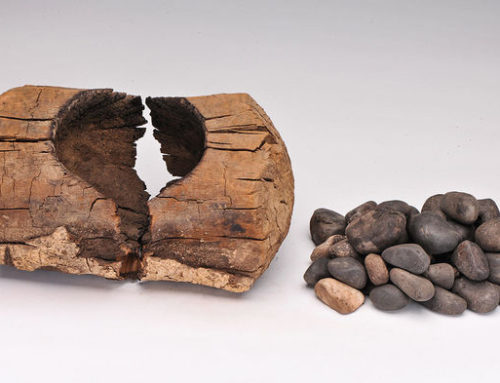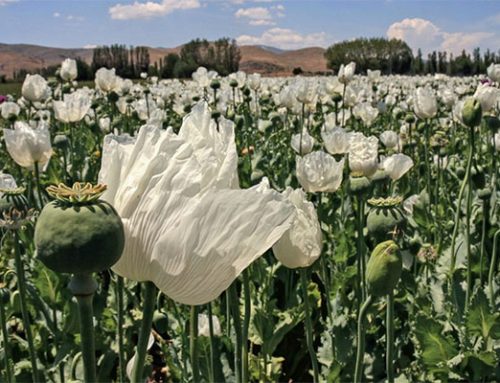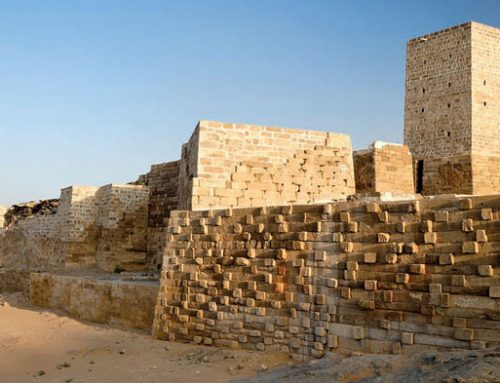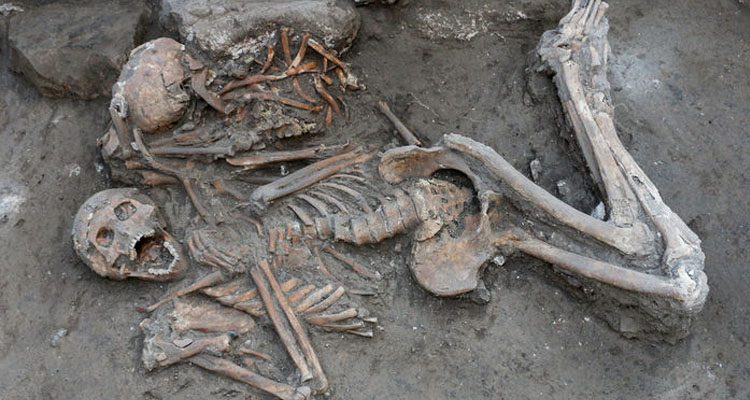
Two men in the ancient city of Megiddo who may have had leprosy were nurtured, not shunned. ROBERT HOMSHER/COURTESY OF THE MEGIDDO EXPEDITION
DENVER—Looming over a strategic spot on Israel’s northern coastal plain, the ancient city of Megiddo was often a battleground, befitting its biblical name Armageddon. But in two Bronze Age tombs, archaeologists are finding signs that, nearly 3500 years ago, Megiddo was also a surprisingly cosmopolitan place. It drew immigrants from what is now Armenia, imported exotic spices from tropical climes, and boasted a state-of-the-art health care system—at least for the elite.
At last week’s annual meeting of the American Schools of Oriental Research here, Israeli and U.S. researchers laid out the first results from the tombs, which were discovered in 2016 and date from when Megiddo was a major metropolis of the Canaanites, the ancient inhabitants of present-day Israel and Lebanon. The finds add to growing evidence of international trade long before the rise of the Assyrian, Persian, and Roman empires. The people of the Bronze Age Middle East “had much more contact with distant places than we give them credit for,” says Eric Cline, an archaeologist at George Washington University in Washington, D.C., and a former member of the project, known as the Megiddo Expedition.
One tomb, dated to about 1600 B.C.E. by radiocarbon and ceramic studies, was a cramped but unusually elaborate vaulted chamber containing nine individuals, including a man between 45 and 60 years old wearing a gold headband, as well as a gold bracelet and other jewelry. Nearby lay a woman aged 25 to 40 with a gold brooch and an elegant silver pin shaped like a duck head. A third skeleton was a child under the age of 10 with similar gold jewelry and two silver rings.
“This seems to be a family grave, given the matching grave goods,” says Melissa Cradic, an archaeologist at the University of California (UC), Berkeley, who led the examination of the tomb. She speculates that the three may represent an elite, if not royal, family that died at about the same time from disease. Analysis of their genetic makeup, which could confirm their family ties, is underway, along with isotopic and other studies that could reveal their diet and health.
The tomb’s biggest surprise emerged when three small jugs were tested for residues. Chromatography and mass spectrometry analysis detected chemical components of vanilla. “This was a shock,” says Vanessa Linares from Tel Aviv University in Israel, who led the team conducting the work. Botanist Pesach Lubinsky of UC Riverside, a vanilla expert who was not involved in the Megiddo research, says the finding is at odds with current thinking on vanilla’s origins. Vanilla is found in tropical orchids on every continent except Antarctica and Australia. Only in Mesoamerica, however, is there evidence of its early domestication, and it was long thought to be unknown in the Old World until the Spanish brought it back from Mexico in the 16th century C.E.
All aromatic vanilla orchids contain a mixture of compounds, including vanilla, 4-hydroxybenzaldehyde, and vanillic acid. The best matches to the residues found in the jugs grow in Mesoamerica, Indonesia, Kenya, and India, Linares says. Ruling out the first two sources because of distance, she speculates that the vanilla may have arrived in Megiddo from Africa, via Egypt, or from India, through trade across the Persian Gulf.
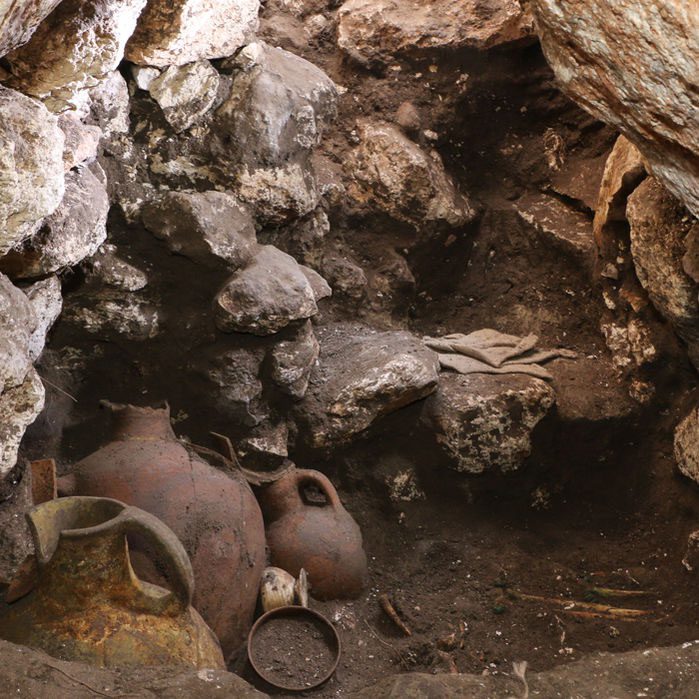
Jugs found in Bronze Age tombs held vanilla residues. ADAM PRINS/COURTESY OF THE MEGIDDO EXPEDITION
“India is the most likely source,” says Cline, who notes the robust trade linking nearby Mesopotamia with India in the Bronze Age. The vanilla may have been traded from southern India through the vestiges of the earlier Indus civilization in the subcontinent’s northwest. But Dorian Fuller, an archaeobotanist at University College London, says he “would be cautious in attributing origins, given the lack of much ethnobotanical evidence for the use of native vanilla.”
The find, if it proves accurate, would support hints of an early and far-flung spice trade in the ancient Middle East. Peppercorns that likely came from Sri Lanka were stuffed into the nose of Egypt’s mummified King Ramses II in 1213 B.C.E., and evidence of cinnamon from Sri Lanka or southern India appears in the Middle East a couple of centuries later.
Investigators also found hints of a grimmer import in a burial pit directly on top of the Megiddo tomb, dating to a century or so later. The pit holds the remains of two men who may have been in their twenties at death. “These were children of misfortune,” says Rachel Kalisher, a Brown University archaeologist who examined the remains. Both men’s bones were pitted, and one had broken his nose and pinky toes, conditions Kalisher says might be due to leprosy. That disease is thought to have spread from Africa to India by 4000 years ago; trade may then have carried it to the Middle East. Genetic testing is underway to determine whether Kalisher’s hunch is correct.
“Their illness left them debilitated, and they needed help to survive,” she adds. Both appear to have been carefully tended. Their teeth lacked the wear typical for men of their age, a sign that they may have been fed a special nonabrasive diet designed for weakened jaws. “There was a societal mechanism of health care—they were not ostracized and clearly were given considerable respect,” Kalisher adds.
At the end of his life, the more debilitated of the two men underwent a drastic treatment: A physician was called in to cut a window into his skull—a practice called trepanation, often used to treat physical, mental, and spiritual disorders in ancient times. “This was done with fine precision and great expertise,” says Kalisher, although the man died within less than a month of the procedure.
Preliminary DNA studies by geneticists Liran Carmel of Hebrew University in Jerusalem and David Reich of Harvard University show the men were brothers. Additional genetic studies may reveal more about their origins and whether they were related to the occupants of the older tomb below.
DNA studies also revealed the far-flung connections of three occupants of another tomb. At the meeting, Carmel said genetic analysis suggests they were recent immigrants from today’s Armenia in the Caucasus, some 1300 kilometers to the north. Unlike the vaulted tomb, which lay near Megiddo’s palace, this tomb was surrounded by humbler houses and graves. If the results hold up, they hint that long-distance travel was not confined to the elite.
Dozens of ancient DNA samples from the region, including many from Megiddo, are now being analyzed, and may soon shed more light on the genetic makeup of the city’s inhabitants, Carmel added.
Glenn Schwartz, an archaeologist at Johns Hopkins University in Baltimore, Maryland, who is not involved with the dig, says the burst of data from Megiddo, rich in genetic and chemical detail, doesn’t just provide fresh insight into this important Bronze Age center. The findings also “illustrate the numerous new techniques derived from the natural sciences that archaeologists are now using to identify the source and identity of the humans, animals, plants, and other materials found in the archaeological record.”

